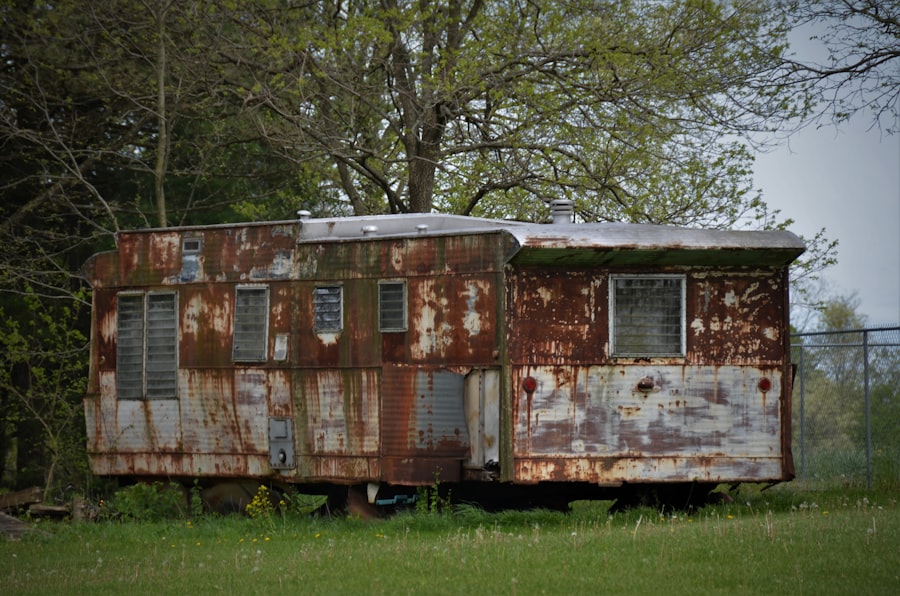Skirting refers to the material that encloses the space between the ground and the bottom of a mobile home. This essential component serves multiple purposes, including aesthetic enhancement, protection against pests, and insulation. The gap beneath a mobile home can create vulnerabilities, allowing cold air to seep in during winter months or hot air to enter during summer.
By installing skirting, homeowners can effectively seal this area, contributing to a more stable indoor climate. Moreover, skirting plays a crucial role in protecting the underbelly of a mobile home from environmental elements. It acts as a barrier against wind, rain, and snow, which can lead to moisture accumulation and potential damage to plumbing and electrical systems.
Additionally, skirting helps deter pests such as rodents and insects from nesting underneath the home. Given these factors, skirting is not merely an aesthetic choice; it is a vital component of mobile home maintenance that contributes to the longevity and efficiency of the structure.
Key Takeaways
- Skirting is the material used to enclose the space beneath a mobile home, providing protection from the elements and enhancing its appearance.
- Common skirting materials include vinyl, metal, concrete, and wood, each with its own advantages and considerations for installation and maintenance.
- When choosing a skirting design, consider the style and color of your mobile home, as well as the climate and potential for moisture and pests in your area.
- Stylish skirting options such as faux stone or brick can greatly enhance the curb appeal of your mobile home, adding value and visual interest.
- DIY installation can save money, but professional installation ensures proper fit and durability; consider your skill level and available time when making this decision.
Different Types of Skirting Materials for Mobile Homes
When it comes to skirting materials for mobile homes, there are several options available, each with its own set of advantages and disadvantages. Vinyl skirting is one of the most popular choices due to its affordability and ease of installation. It comes in various colors and styles, allowing homeowners to customize their mobile homes while providing a durable barrier against the elements.
Vinyl is also resistant to rot and decay, making it a long-lasting option for many homeowners. Another common material is metal skirting, which offers superior durability and strength. Aluminum or galvanized steel skirting can withstand harsh weather conditions and provide excellent protection against pests.
However, metal skirting can be more expensive than vinyl and may require professional installation due to its weight and complexity. Additionally, some homeowners opt for concrete skirting, which provides a solid foundation and excellent insulation properties. While concrete is highly durable, it can be labor-intensive to install and may not offer the same aesthetic flexibility as other materials.
Choosing the Right Skirting Design to Complement Your Mobile Home

Selecting the right skirting design is crucial for achieving a cohesive look that complements the overall aesthetic of your mobile home. The design should harmonize with the architectural style of the home while also considering the surrounding landscape. For instance, a modern mobile home may benefit from sleek, minimalist skirting designs that emphasize clean lines and contemporary materials.
In contrast, a more traditional mobile home might look best with decorative skirting that features intricate patterns or textures. Color is another important factor in choosing skirting design. Homeowners should consider the color palette of their mobile home when selecting skirting materials.
A well-coordinated color scheme can enhance the visual appeal of the property and create a unified appearance. Additionally, homeowners should think about the height of the skirting; taller skirting can create a more substantial look, while shorter options may lend a lighter feel to the structure. Ultimately, the right design will not only enhance curb appeal but also reflect the homeowner’s personal style.
Enhancing Curb Appeal with Stylish Skirting Options
| Skirting Option | Material | Cost | Maintenance | Installation |
|---|---|---|---|---|
| Vinyl | PVC | Low | Low | Easy |
| Brick | Brick veneer | Medium | Low | Complex |
| Stone | Natural stone | High | Low | Complex |
Curb appeal is an essential aspect of any home, including mobile homes. Stylish skirting options can significantly enhance this appeal by adding character and charm to the property. Decorative vinyl skirting with embossed patterns or textures can create an elegant look that mimics traditional siding materials.
This type of skirting can be particularly effective in neighborhoods where mobile homes are often viewed as less attractive than traditional houses. In addition to decorative options, homeowners can also explore custom skirting solutions that incorporate unique elements such as latticework or stone veneer. Lattice skirting allows for ventilation while adding an element of sophistication to the home’s exterior.
Stone veneer skirting provides a rustic charm that can make a mobile home appear more like a traditional house. By investing in stylish skirting options, homeowners not only improve their property’s appearance but also increase its market value.
DIY vs Professional Installation: Pros and Cons
When it comes to installing skirting on a mobile home, homeowners often face the decision between DIY installation and hiring professionals. DIY installation can be an appealing option for those looking to save money or who enjoy hands-on projects. Many skirting materials come with detailed instructions that make installation straightforward for those with basic tools and skills.
Additionally, taking on the project yourself allows for greater control over design choices and customization. However, there are potential downsides to consider with DIY installation. If not done correctly, improper installation can lead to issues such as gaps that allow pests or moisture to enter, undermining the very purpose of skirting.
On the other hand, professional installation ensures that the job is done correctly and efficiently, often backed by warranties or guarantees on workmanship. While this option may come at a higher cost, it can save homeowners from future headaches related to maintenance or repairs.
Maintenance and Care Tips for Long-Lasting Skirting

To ensure that skirting remains functional and visually appealing over time, regular maintenance is essential. Homeowners should periodically inspect their skirting for signs of damage or wear, such as cracks in vinyl or rust on metal materials. Addressing these issues promptly can prevent more significant problems down the line.
For instance, small cracks in vinyl can be repaired with specialized adhesives or patches designed for outdoor use. Cleaning is another important aspect of maintenance. Dirt, debris, and algae can accumulate on skirting over time, detracting from its appearance.
Homeowners should regularly wash their skirting with mild soap and water using a soft brush or cloth to avoid scratching the surface. For tougher stains or mildew, a mixture of vinegar and water can be effective without damaging the material. By following these maintenance tips, homeowners can extend the life of their skirting while keeping their mobile homes looking fresh and inviting.
Adding Insulation and Energy Efficiency with Skirting
One of the often-overlooked benefits of proper skirting installation is its potential to enhance energy efficiency in mobile homes. By sealing off the space beneath the home, skirting helps regulate temperature fluctuations that can lead to increased heating and cooling costs. Insulated skirting options are available that provide an additional layer of thermal protection, helping to keep homes warmer in winter and cooler in summer.
Incorporating insulation into skirting not only improves energy efficiency but also contributes to overall comfort within the home. For example, insulated panels can reduce drafts that might otherwise seep through gaps in unskirted areas. This added insulation can be particularly beneficial in regions with extreme weather conditions where energy costs can skyrocket during peak seasons.
Homeowners who invest in insulated skirting may find that they experience lower utility bills while enjoying a more comfortable living environment.
Budget-Friendly Skirting Options for Mobile Home Owners
For many mobile home owners, budget constraints are a significant consideration when selecting skirting materials. Fortunately, there are several budget-friendly options available that do not compromise on quality or aesthetics. Vinyl skirting remains one of the most economical choices due to its low cost and wide availability in various styles and colors.
Many manufacturers offer DIY kits that include all necessary components for installation at an affordable price point. Another cost-effective option is using plywood or treated wood for skirting. While wood requires more maintenance than vinyl or metal options, it can be painted or stained to match the mobile home’s exterior at a fraction of the cost of more durable materials.
Additionally, some homeowners have found success using recycled materials such as pallets or reclaimed wood to create unique and visually appealing skirting solutions without breaking the bank. By exploring these budget-friendly options, mobile home owners can achieve functional and attractive skirting without overspending.

